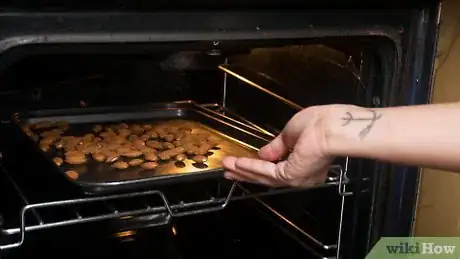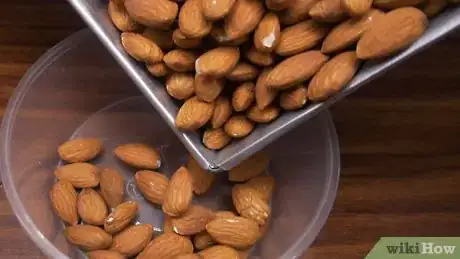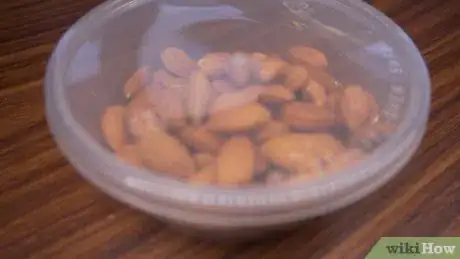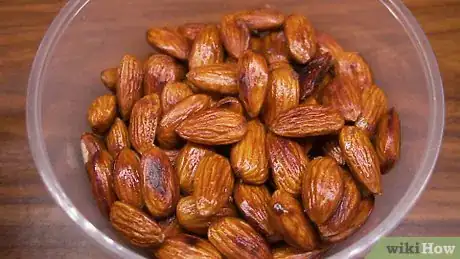This article was co-authored by Vanna Tran, a trusted member of wikiHow's volunteer community. Vanna Tran is a home cook who started cooking with her mother at a very young age. She has catered events and hosted pop-up dinners in the San Francisco Bay Area for over 5 years.
wikiHow marks an article as reader-approved once it receives enough positive feedback. This article received 12 testimonials and 93% of readers who voted found it helpful, earning it our reader-approved status.
This article has been viewed 624,643 times.
Learn more...
Almonds are a healthy snack containing plenty of vitamins and minerals, like magnesium, copper, zinc, potassium, and iron. When they're roasted, not only are they good for you, they're also delicious. Make them in the oven or, if you're short on time, roast them on the stove top. For extra flavor, toss them in oil, spices, and seasonings.
Ingredients
- 1 pound (0.45 kg) of whole raw almonds
- Extra virgin olive oil (optional)
- 1⁄2 pound (0.23 kg) of whole raw almonds, unsalted
- 1 teaspoon (4.9 ml) of extra virgin olive oil
- 1⁄2 teaspoon (2.5 ml) of sea salt
Steps
Making Oven-Roasted Almonds
-
1Preheat the oven to 350 °F (177 °C). Most ovens take about 20 minutes to heat up but it will depend on how efficient your model is. Let the oven start heating while you prepare the almonds.[1]
- Trying to set the oven at a higher temperature to cook the almonds faster will likely burn the almonds or not cook them thoroughly.
-
2Spread the almonds in a single layer on an ungreased baking sheet. You don’t need to grease the baking sheet because the nuts contain so much natural oil. To help them cook evenly, make sure they are in an even layer and not piled on top of each other.[2]
- Substitute a 9 in × 13 in (23 cm × 33 cm) baking dish for the baking sheet if you'd like.
- If you want to coat the nuts in olive oil and other seasonings, toss them in your choice of oil and spices directly on the baking sheet or beforehand in a separate mixing bowl.
Topping Options for Roasted Almonds
Sweet: Sugar, cinnamon sugar, honey, cocoa powder
Savory: Sea salt, garlic powder, seasoned salt, rosemary, barbecue sauce
Spicy: Chili powder, hot sauce, buffalo sauce, sriracha, black pepper
Advertisement -
3Place the almonds in the oven for 10-15 minutes, stirring frequently. Use a spatula to stir the almonds or gently shake the baking sheet to move the almonds around. Roast them until they’re golden brown and fragrant.[3]
- The almonds on the edges tend to cook faster so move them to the middle and vice versa when you stir. This allows all of the nuts to roast evenly.
- Check the nuts often to ensure they aren’t burning or browning unevenly. If they're cooking unevenly, stir them. If they're burnt, remove them from the oven.
-
4Remove the nuts from the oven and place them on another baking sheet. The high oil content of the almonds means they’ll keep cooking outside of the oven, especially if they’re left on the hot baking sheet. Pour or spoon them onto a cool baking sheet.[4]
- Leaving the almonds on the hot baking sheet will burn them or scorch the bottoms.
- If you don’t have another baking sheet, a plate or even a paper towel will do.
-
5Let the almonds cool completely before pouring into an airtight container. Storing almonds while they’re still warm increases their risk of molding or going bad because it creates excess moisture. Wait until they’re cool to the touch, then place them in a sealed plastic or glass container.[5]
- You can use a resealable plastic bag or glass jar, too.
-
6Store dry roasted nuts for 9 to 12 months in the pantry. Place your almonds in a cool, dark place that’s dry to keep them fresh for longer. Throw them away if you notice a rancid odor or if they taste stale.[6]
- If you coated the nuts in oil, they won’t last as long. A good rule of thumb for those is 3 to 4 weeks at room temperature.
- To keep the nuts for up to 2 years, place the airtight container in the freezer if it’s freezer-safe.
Making Pan-Roasted Almonds on a Stove Top
-
1Toss the almonds, olive oil, and sea salt together. Combine the 3 ingredients in a large mixing bowl. Use a spoon to mix the almonds until they are evenly coated with olive oil and salt.[7]
- Swap olive oil for a different type of oil based on your taste preferences. You could use avocado oil, sesame oil, or an herb-infused oil, for example.
- You can also use water or lemon juice instead of oil.
- Another mixing option is to put the 3 ingredients in a resealable plastic bag. Shake it vigorously to coat the almonds.
-
2Heat a skillet on the stove top over medium-high heat. You don’t want the pan to be so hot that it burns the almonds. If your stove top dial has 9 settings, medium-high heat would be anywhere from 5 to 7. Choose a skillet that’s big enough that the almonds won’t be overcrowded.[8]
- A cast iron skillet or a frying pan with high edges will also work.
- To determine what medium-high heat is, hold your hand 2 to 3 inches (5.1 to 7.6 cm) above the burner. If you can hold it there for a few minutes before it gets too hot, it’s medium to medium-high.[9]
-
3Pour the almonds into the heated skillet and roast them for 5 minutes. Keep the almonds on the stove until they’re a golden-brown color. Stir them frequently with a spatula so they don’t stick to the bottom of the skillet.[10]
- Sample 1 almond after the 5 minutes is up. If it doesn’t taste fully roasted, continue cooking the almonds.
-
4Let the almonds cool completely on a baking sheet. The almonds need to be cooled before they can be stored so you don’t trap moisture in the container and risk ruining them. Spread them in a single layer on the baking sheet for the fastest cooling time.
- You can use a sheet of parchment paper instead of a baking sheet.
- Don’t leave the almonds in the pan to cool as the heat will continue cooking them.
-
5Store the almonds in a container at room temperature for 3 to 4 weeks. Choose an airtight plastic or glass container to keep the almonds fresh. A dry, dark area like the pantry or a cupboard is best for storage.[11]
- Eat the almonds as a snack or use them as salad or yogurt toppings.
Community Q&A
-
QuestionHow do I remove the skin from almonds?
 Community AnswerBlanch them in boiled water, then drain them in a colander. The skins peel off easily.
Community AnswerBlanch them in boiled water, then drain them in a colander. The skins peel off easily. -
QuestionCan almonds be eaten raw?
 Community AnswerYes! I eat them like this all the time. The only difference is they are harder, and less nutty, but they do have a slight sweet taste.
Community AnswerYes! I eat them like this all the time. The only difference is they are harder, and less nutty, but they do have a slight sweet taste. -
QuestionHow long do these last?
 Community AnswerThey should last a few months if they are stored properly in a sealed container.
Community AnswerThey should last a few months if they are stored properly in a sealed container.
Things You’ll Need
Oven-Roasted Almonds
- 2 baking sheets
- Spatula
- Airtight container
- Mixing bowl (optional)
- Spoon (optional)
Pan-Roasted Almonds
- Large mixing bowl
- Spoon
- Skillet
- Spatula
- Baking sheet
- Airtight container
References
- ↑ https://elanaspantry.com/how-to-roast-almonds/
- ↑ https://www.thekitchn.com/how-to-toast-nuts-in-the-oven-cooking-lessons-from-the-kitchn-181294
- ↑ https://snack-girl.com/snack/how-do-i-roast-almonds/
- ↑ https://www.thekitchn.com/how-to-toast-nuts-in-the-oven-cooking-lessons-from-the-kitchn-181294
- ↑ https://www.thekitchn.com/how-to-toast-nuts-in-the-oven-cooking-lessons-from-the-kitchn-181294
- ↑ https://www.eatbydate.com/proteins/nuts/how-long-do-nuts-last-shelf-life-expiration-date/
- ↑ https://simpleveganblog.com/spicy-pan-roasted-almonds/
- ↑ https://simpleveganblog.com/spicy-pan-roasted-almonds/
- ↑ https://www.reluctantgourmet.com/how-hot-should-you-heat-your-pan-when-sauteing/
About This Article
To roast raw almonds, start by spreading them in a single layer on an ungreased baking sheet. You can also add sugar, honey, garlic powder, or salt to add some flavor to your almonds. Once you’ve spread them on a tray, place them in the oven at 350 degrees Fahrenheit for 10-15 minutes or until they’re golden brown. While they’re roasting, stir the almonds with a spatula so they cook evenly. When the almonds are cooked, remove them from the oven and transfer them to another baking sheet, which will cool them down. If you want to store your roasted almonds, make sure they’ve cooled down completely before sealing them in a container to prevent them going moldy from excess moisture. For more tips from our Cook co-author, including how to roast almonds in a pan, read on!



























































